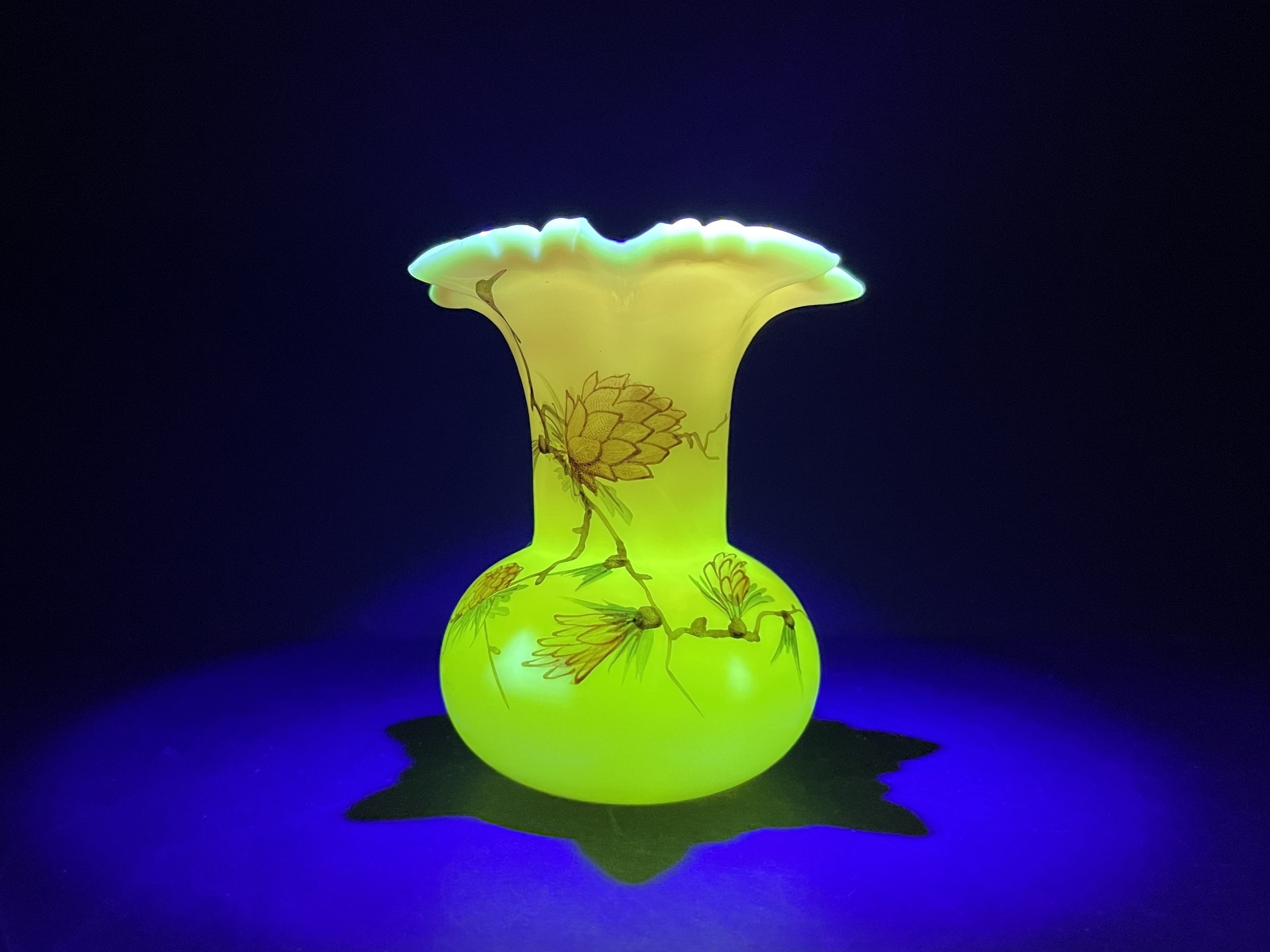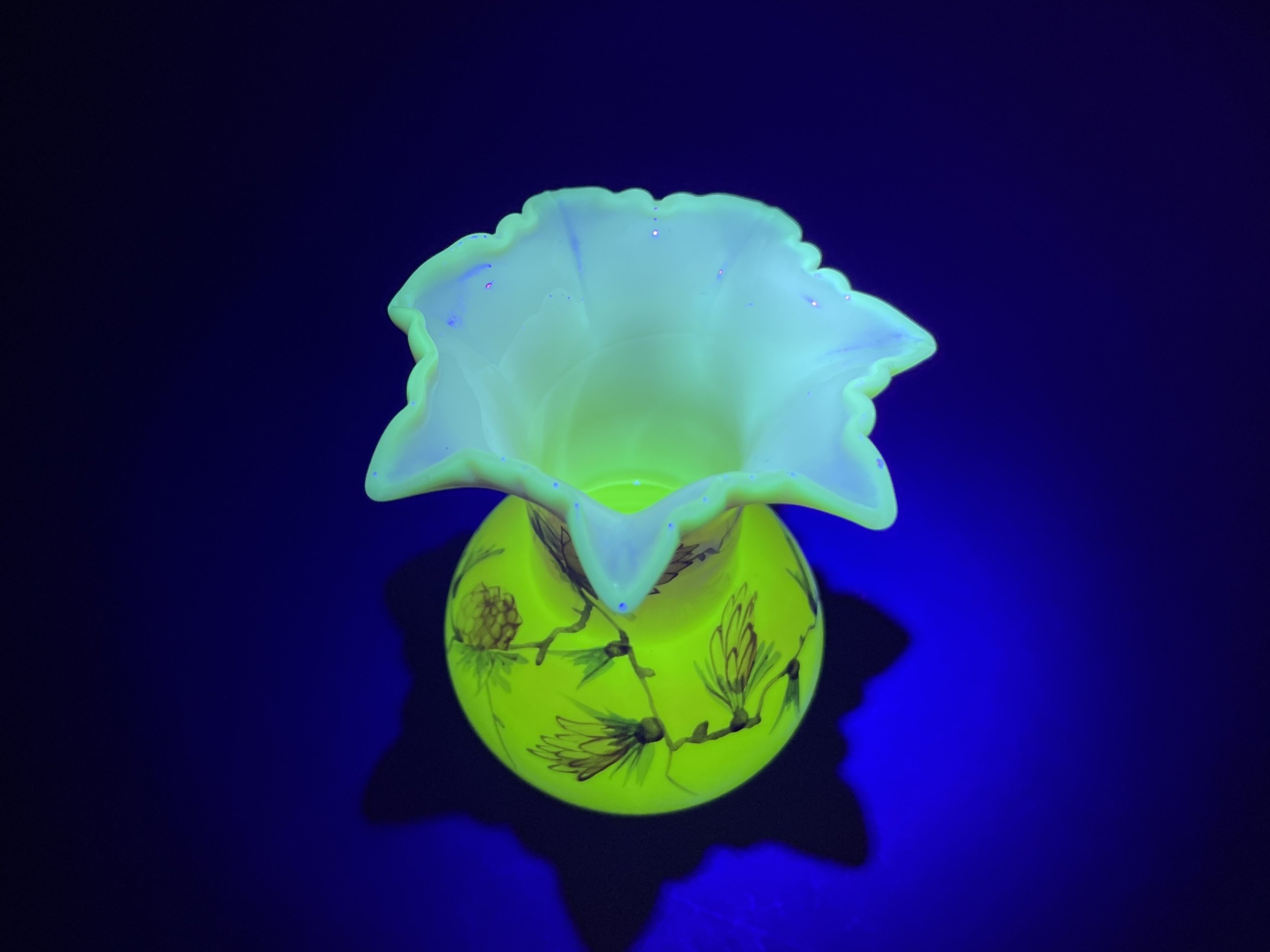









Rare Thomas Webb Gloss Queens Burmese Glass Vase Hand painting attributed to the studio of Jules Barbe c.1888
A wonderful 1890's Victorian Stourbridge glass vase. Made in Burmese glass by the British firm Thomas Webb & Sons.
note: images taken with UV light torch, 395nm wavelength.
This particular little vase is more collectable as it has a gloss finish to the glass, usually Burmese has a matt finish where acid has been applied but in some cases some didn't and have been left with a high gloss.
Also the vase has a acid etched makers mark and patent Number.
Height 9 x Width 9 cm
Larch design, attributed to the studio of Jules Barbe during the period 1886 - 1888. The decoration of Queen’s Burmese Ware at Thomas Webb & Sons was carried out in the decorating shop under the direction of Jules Barbe, a Frenchman recruited by Thomas Wilkes Webb at the 1878 Paris International Exhibition.
The enameled decoration is typically done in flat enamels, with most designs incorporating additional leaves, applied in a blue/grey wash, which resemble shadows and give the decoration a three dimensional effect. Where the enamel is raised from the surface, it is usually in the form of paste details, such as dots in the centre of flowers, to represent the stamens, or to represent tendrils on Ivy.
All items are sensitively and minimally cleaned
Any questions please don't hesitate to drop me a message. I am very happy to pass on any additional information, or images you may need, if you are interested in more than one item I can arrange a combined postage price. Many thanks.
All items will be packaged using recycled or reused materials to help minimise any environmental impact.
Please be aware that you are purchasing a vintage item. We mention any obvious defects to the glass such as chips, cracks, etc. in our description but there may also be minor manufacturing faults eg. marks from the mould, straw marks and air bubbles, which is normal for glass of this era.
A wonderful 1890's Victorian Stourbridge glass vase. Made in Burmese glass by the British firm Thomas Webb & Sons.
note: images taken with UV light torch, 395nm wavelength.
This particular little vase is more collectable as it has a gloss finish to the glass, usually Burmese has a matt finish where acid has been applied but in some cases some didn't and have been left with a high gloss.
Also the vase has a acid etched makers mark and patent Number.
Height 9 x Width 9 cm
Larch design, attributed to the studio of Jules Barbe during the period 1886 - 1888. The decoration of Queen’s Burmese Ware at Thomas Webb & Sons was carried out in the decorating shop under the direction of Jules Barbe, a Frenchman recruited by Thomas Wilkes Webb at the 1878 Paris International Exhibition.
The enameled decoration is typically done in flat enamels, with most designs incorporating additional leaves, applied in a blue/grey wash, which resemble shadows and give the decoration a three dimensional effect. Where the enamel is raised from the surface, it is usually in the form of paste details, such as dots in the centre of flowers, to represent the stamens, or to represent tendrils on Ivy.
All items are sensitively and minimally cleaned
Any questions please don't hesitate to drop me a message. I am very happy to pass on any additional information, or images you may need, if you are interested in more than one item I can arrange a combined postage price. Many thanks.
All items will be packaged using recycled or reused materials to help minimise any environmental impact.
Please be aware that you are purchasing a vintage item. We mention any obvious defects to the glass such as chips, cracks, etc. in our description but there may also be minor manufacturing faults eg. marks from the mould, straw marks and air bubbles, which is normal for glass of this era.